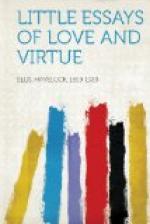It is clear that this kind of education and this attitude towards children must be regarded as the outcome of the whole mediaeval method of life. In a state of society where roughness and violence, though not, as we sometimes assume, chronic, were yet always liable to be manifested, it was necessary for every man and woman to be able to face the crudest facts of the world and to be able to maintain his or her own rights against them. The education that best secured that strength and independence was the best education and it necessarily involved an element of hardness. We must go back earlier than Montaigne’s day, when the conditions were becoming mitigated, to see the system working in all its vigour.
The lady of the day of the early thirteenth century has been well described by Luchaire in his scholarly study of French Society in the time of Philip Augustus. She was, he tells us, as indeed she had been in the preceding feudal centuries, often what we should nowadays call a virago, of violent temperament, with vivid passions, broken in from childhood to all physical exercises, sharing the pleasures and dangers of the knights around her. Feudal life, fertile in surprises and in risks, demanded even in women a vigorous temper of soul and body, a masculine air, and habits also that were almost virile. She accompanied her father or her husband to the chase, while in war-time, if she became a widow or if her husband was away at the Crusades, she was ready, if necessary, to direct the defences of the lordship, and in peace time she was not afraid of the longest and most dangerous pilgrimages. She might even go to the Crusades on her own account, and, if circumstances required, conduct a war to come out victoriously.
We may imagine the robust kind of education required to produce people of this quality. But as regards the precise way in which parents conducted that education, we have, as Luchaire admits, little precise knowledge. It is for the most part only indirectly, by reading between the lines, that we glean something as to what it was considered befitting to inculcate in a good household, and as what we thus learn is mostly from the writings of Churchmen it is doubtless a little one-sided. Thus Adam de Perseigne, an ecclesiastic, writes to the Countess du Perche to advise her how to live in a Christian manner; he counsels her to abstain from playing games of chance and chess, not to take pleasure in the indecent farces of actors, and to be moderate in dress. Then, as ever, preachers expressed their horror of the ruinous extravagance of women, their false hair, their rouge, and their dresses that were too long or too short. They also reprobated their love of flirtation. It was, however, in those days a young girl’s recognised duty, when a knight arrived in the household, to exercise the rites of hospitality, to disarm him, give him his bath, and if necessary massage him to help him to go to sleep. It is not surprising that the young girl sometimes made love to the knight under these circumstances, nor is it surprising that he, engaged in an arduous life and trained to disdain feminine attractions, often failed to respond.




